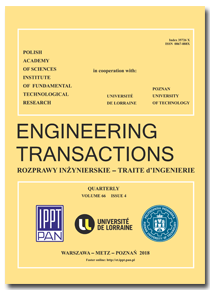10.24423/engtrans.130.2012
Analysis of the Cutting Parameters Influence During Machining Aluminium Alloy A2024-T351 with Uncoated Carbide Inserts
References
ABAQUS Documentation for version 6.8. Dassault Systems Simulia, 2008.
Johnson G.R., Cook W.H., Fracture characteristics of three metals subjected to various strains, strain rates, temperatures and pressures, Engineering Fracture Mechanics, 21, 31–48, 1985.
Li K., Gao X.-L., Sutherland J.W., Finite element simulations of the orthogonal metal cutting process for qualitative understanding of the effects of crater wear on the chip formation process, Journal of Materials Processing Technology, 127, 309–324, 2002.
Limido J., Espinosa C., Sala¨un M., Lacome J.L., SPH method applied to high speed cutting modelling, International Journal of Mechanical Sciences, 49, 898-908, 2007.
List G., Nouari M., G´ehin D., Gomez S., Manaud J.P., Le Petitcoprs Y., Girot F., Wear behaviour of cemented carbide tools dry machining of aluminium alloy, Wear, 259, 1177–1189, 2005.
Mebrouki T., Girardin F., Asad M., Rigal J-F., Numerical and experimental study of dry cutting for an aeronautic aluminium alloy (A2024-T351), International Journal of Machine Tools and Manufacture, 48, 1187–1197, 2008.
Molinari A., Moufki A., The Merchant’s model of orthogonal cutting revisited: A new insight into the modelling of chip formation, International Journal of Mechanical Sciences, 50, 124–131, 2008.
Ozlu E., Budak E., Molinari A., Analytical and experimental investigation of rake contact and friction behaviour in metal cutting, International Journal of Machine Tools and Manufacture, 49, 865–875, 2009.
DOI: 10.24423/engtrans.130.2012




